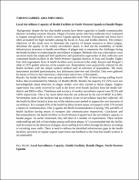| dc.description.abstract | TABANI GABRIEL (2012-MI91-10025)
Local Surveillance Capacity of Health Facilities in North-Western Uganda to Handle Plague
Background: despite the fact that health systems have better capacities to handle communicable diseases including zoonotic diseases, Plague (Yersinia pestis infection) outbreaks have continued to happen unexpectedly in north western Uganda getting everyone ill-prepared and hence have often accounted for high mortality among the locals in Arua and Zombo districts. The primary objectives of this study were to determine the capacity of human resources to detect plague, determine the quality of the weekly surveillance report, to find out the availability of health infrastructure necessary to handle surveillance of plague and, to enumerate the challenges facing the health facilities in conducting the surveillance of plague. Methods: this was a descriptive cross sectional study that employed both qualitative and quantitative approaches of data collection and constituted health facilities in the North-Western Ugandan districts of Arua and Zombo. Eighty four (84) respondents from 14 health facilities were involved in the study; Krejcie and Morgan‟s table of 1970 guided selection of the sample size. Respondents were purposively selected for the health facilities with the simple random method used in selection of respondents. The study instruments included questionnaires, key informants interview and checklist. Data were gathered by means of face-to-face interviews, observation and review of documents.
Results: the health facilities were grossly understaffed with 79% of them having staffing levels below that recommended by Ministry of Health (MoH). Besides the majority (51.25%) were not knowledgeable about detection of plague neither were they trained to detect plague. Support supervision was rarely received by staff in the lower level health facilities from the health sub-district and DHOs office. Timeliness and accuracy of weekly surveillance reports were 95.5% and 100% respectively. This is far much better than the one achieved by the end of HSSP II at 68%. Nevertheless most of the facilities had no evidence of use of surveillance data they collected. All the health facilities lacked at least two of the infrastructure needed to support the core functions of surveillance. For example 43% of the health facilities lacked means of transport while 57% lacked a means of communication. This is against the MoH recommendation of having 70% and 80% of health facilities having means of transport and communication respectively. Conclusion and Recommendation: the health facilities in North-Western Uganda lack the surveillance capacity to handle plague. As earlier mentioned, they fall short of a number of requirements. These include understaffing and lack of knowledge among staff about plague. It‟s recommended that the facility staff be trained on the detection of plague, boost staffing levels either through the district seconding or recruiting more staffs. There is need to address the identified infrastructure gaps in the health facilities; provision of regular support supervision and feedback to the front line health workers is recommended.
Key Words: TABANI GABRIEL (2012-MI91-10025)
Local Surveillance Capacity of Health Facilities in North-Western Uganda to Handle Plague
Background: despite the fact that health systems have better capacities to handle communicable diseases including zoonotic diseases, Plague (Yersinia pestis infection) outbreaks have continued to happen unexpectedly in north western Uganda getting everyone ill-prepared and hence have often accounted for high mortality among the locals in Arua and Zombo districts. The primary objectives of this study were to determine the capacity of human resources to detect plague, determine the quality of the weekly surveillance report, to find out the availability of health infrastructure necessary to handle surveillance of plague and, to enumerate the challenges facing the health facilities in conducting the surveillance of plague. Methods: this was a descriptive cross sectional study that employed both qualitative and quantitative approaches of data collection and constituted health facilities in the North-Western Ugandan districts of Arua and Zombo. Eighty four (84) respondents from 14 health facilities were involved in the study; Krejcie and Morgan‟s table of 1970 guided selection of the sample size. Respondents were purposively selected for the health facilities with the simple random method used in selection of respondents. The study instruments included questionnaires, key informants interview and checklist. Data were gathered by means of face-to-face interviews, observation and review of documents.
Results: the health facilities were grossly understaffed with 79% of them having staffing levels below that recommended by Ministry of Health (MoH). Besides the majority (51.25%) were not knowledgeable about detection of plague neither were they trained to detect plague. Support supervision was rarely received by staff in the lower level health facilities from the health sub-district and DHOs office. Timeliness and accuracy of weekly surveillance reports were 95.5% and 100% respectively. This is far much better than the one achieved by the end of HSSP II at 68%. Nevertheless most of the facilities had no evidence of use of surveillance data they collected. All the health facilities lacked at least two of the infrastructure needed to support the core functions of surveillance. For example 43% of the health facilities lacked means of transport while 57% lacked a means of communication. This is against the MoH recommendation of having 70% and 80% of health facilities having means of transport and communication respectively. Conclusion and Recommendation: the health facilities in North-Western Uganda lack the surveillance capacity to handle plague. As earlier mentioned, they fall short of a number of requirements. These include understaffing and lack of knowledge among staff about plague. It‟s recommended that the facility staff be trained on the detection of plague, boost staffing levels either through the district seconding or recruiting more staffs. There is need to address the identified infrastructure gaps in the health facilities; provision of regular support supervision and feedback to the front line health workers is recommended.
Key Words: Local Surveillance, Capacity, Health Facilities, Handle Plague, North-Western Uganda | en_US |


